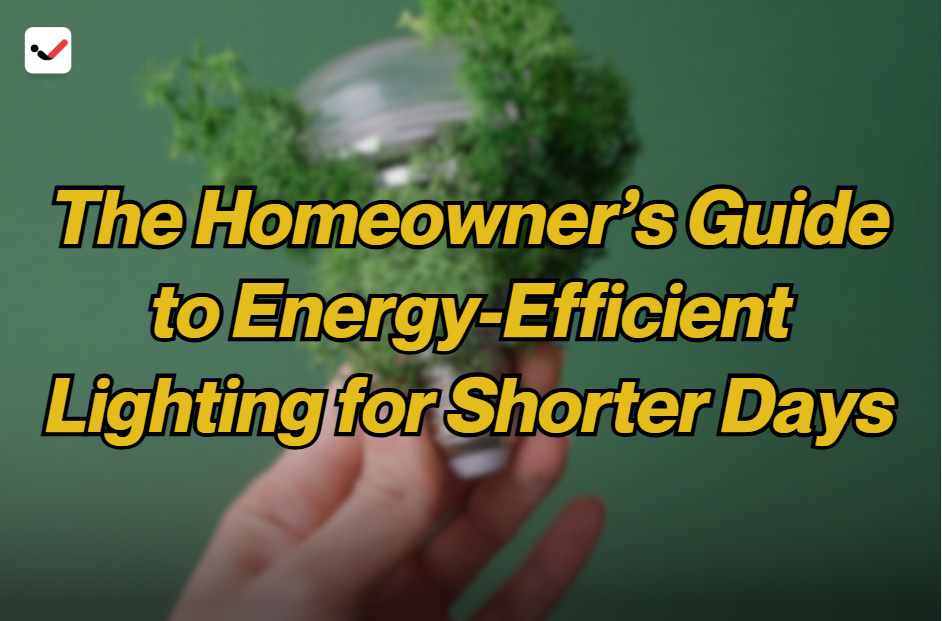The Homeowner’s Guide to Energy-Efficient Lighting for Shorter Days
The Homeowner’s Guide to Energy-Efficient Lighting for Shorter Days

As the days get shorter in fall and winter, your home depends more on artificial light. This means lights are on for more hours each day, which can quickly raise your energy bill. Many homeowners don’t realize how much electricity is wasted by using old bulbs or lighting spaces that don’t need it. But with a few smart changes, you can brighten your home while saving money and energy at the same time.
Energy-efficient lighting is one of the easiest ways to cut electricity costs and reduce your carbon footprint. Whether you’re upgrading to LED bulbs, using motion sensors, or choosing the right lighting for each room, small adjustments can make a big impact. This guide will walk you through practical tips for smarter lighting at home during the darker seasons.
Switch to LED Light Bulbs
If you're still using incandescent or halogen bulbs, it's time to upgrade to LED lighting for homes. LED bulbs use up to 80% less energy and last up to 25 times longer than traditional bulbs. That means fewer replacements, less waste, and lower electric bills.
LEDs also produce less heat, which is safer and more efficient. You can find LED bulbs in various brightness levels and color temperatures, so they fit every room, from warm lighting in the living room to brighter daylight-style bulbs in workspaces. Choosing energy-saving LED bulbs is one of the smartest steps you can take to lower your home lighting costs during fall and winter.
Use Smart Lighting Controls
Smart lighting solutions help you use light only when and where you need it. Timers, dimmers, motion sensors, and smart bulbs can all help reduce wasted electricity. For example, motion-sensor lights in hallways, bathrooms, and closets ensure the lights turn off automatically when no one’s around.
You can also program smart bulbs to turn on and off at specific times or control them remotely from your phone. This is great for people who forget to switch off lights or want their home to appear occupied while they’re away. Automated lighting systems offer both energy savings and convenience, especially during the darker months.
Maximize Natural Light
Even in fall and winter, there’s still sunlight; you just need to make the most of it. Keep your windows clean to let in more daylight, and open curtains or blinds during the brightest parts of the day. Arrange furniture and workspaces near windows whenever possible to reduce the need for artificial lighting.
Use light-colored paint and reflective surfaces to help bounce natural light around the room. Mirrors, glass furniture, or light rugs can all help spread light further. Daylight harvesting is a simple and free way to reduce electricity use without sacrificing brightness or comfort.
Choose the Right Lighting for Each Room
Different rooms have different lighting needs. In bedrooms and living rooms, softer, warmer light is more relaxing. In kitchens and bathrooms, brighter and cooler light makes it easier to see clearly. Matching the right type of bulb to each room’s purpose improves comfort while using less energy.
Don’t over-light spaces. Many people use bulbs that are too bright for the room. This wastes energy and can make the space feel harsh. Look at the lumens on the bulb label to find the right amount of light instead of just looking at the watts.
Install Outdoor Lighting Wisely
With less daylight in the evenings, outdoor lighting becomes more important. But it also adds to your energy use. Use solar-powered lights along walkways, gardens, and porches to save electricity. These lights charge during the day and turn on automatically at night, no wiring or outlets required.
If you prefer wired outdoor lighting, choose LED floodlights with motion sensors. These only turn on when needed, saving electricity while keeping your property safe. Avoid leaving outdoor lights on all night, especially if they’re not LED.
Upgrade to Energy Star Fixtures
When replacing light fixtures, look for the ENERGY STAR label. These certified fixtures use less power and work better with energy-efficient bulbs. Ceiling fans with lights, wall sconces, and even chandeliers come in ENERGY STAR-rated versions that reduce energy use without sacrificing style.
Even though ENERGY STAR fixtures may cost more up front, they save you money over time through lower electricity use and fewer bulb replacements. They’re a smart investment in energy-efficient home upgrades.
Use Task Lighting Instead of Full-Room Lighting
Sometimes you don’t need to light the entire room, just the area where you’re working or reading. That’s where task lighting comes in. Desk lamps, reading lights, and under-cabinet lighting are great for focusing light where it’s needed.
Using smaller, targeted lights reduces your electricity use and avoids lighting up areas that aren’t being used. It also creates a more comfortable and efficient space, especially during shorter days when lights stay on longer.
Create Lighting Zones
Break your home into lighting zones to better control energy use. For example, you might group lights in the kitchen, living room, or hallway on separate switches or circuits. That way, you don’t light the whole house just to go from one room to another.
Smart lighting systems let you control these zones with your phone or voice assistant, making it even easier to manage lighting across your home. Zoning reduces energy waste and gives you more control over your home’s ambiance and efficiency.
Keep Fixtures Clean and Well-Maintained
Dust and dirt on light fixtures can block light and make rooms feel dimmer. This often leads people to use brighter bulbs or add more lamps, which use more energy. Regularly clean your bulbs, covers, and shades to ensure maximum brightness from your current setup.
Also, check for loose connections or flickering lights, which can be signs of a problem. Keeping your lighting system in good condition improves efficiency and prevents small issues from becoming bigger electrical problems.
Making your home brighter and more energy-efficient doesn’t have to be complicated. By switching to LED bulbs, using smart lighting controls, and choosing the right fixtures, you can lower your electricity bill without sacrificing comfort. Small changes in your lighting habits can make a big difference during the shorter days of fall and winter.
As energy costs continue to rise, finding ways to reduce energy use at home becomes even more important. Use these tips to improve your home lighting efficiency, save money, and stay comfortable all season long. Your wallet and the planet will thank you.

